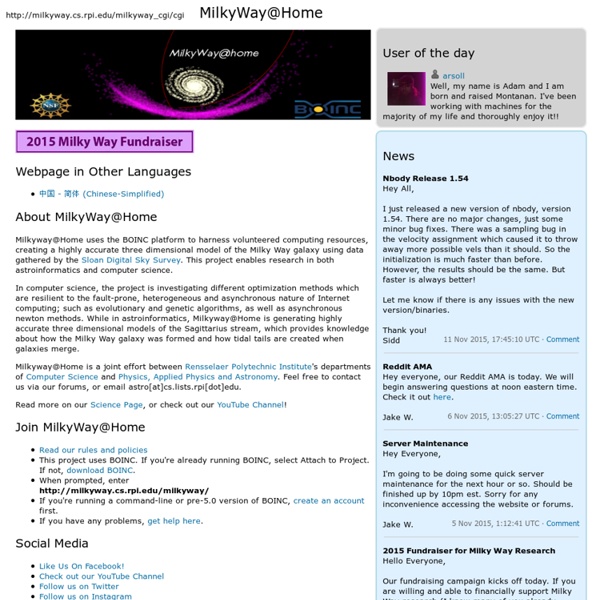



Rosetta@home Fluorescent proteins designed from scratch Congrats to all Rosetta@home volunteers who contributed to a recent report in Nature describing the design of a completely artificial fluorescent beta-barrel protein. As described by one of the main authors, Anastassia, in this forum post: The paper presents many “firsts” in computational protein design. Thanks to all the Rosetta@home volunteers who contributed to the validation of our designed proteins and binding sites. Here is the link to the IPD webpage that contains a copy of the paper. 17 Sep 2018, 23:14:21 UTC · Discuss Congrats to the collaborative WeFold group for their recent paper published in Nature Scientific Reports. Rosetta Android version 4.10 released ... more theSkyNet POGS - the PS1 Optical Galaxy Survey You helped name an exoplanet! Hi Everyone, Some great news announced yesterday by the International Astronomical Union - theSkyNet's name suggestion was selected for an exoplanet! The planet around the star Pollux is now named Thestias thanks to djrichmatthews' suggestion. You might notice that Thestias is suspiciously NOT the name we submitted (which was Leda). We're SO EXCITED with this result, congratulations to everyone who suggested, voted and was involved, it was a true team effort and we're so pleased that your name was chosen. -Kirsten and theSkyNet team 17 Dec 2015, 4:18:23 UTC · Comment Area 25,000,000 Yesterday we processed the 25 millionth area of POGS. The two lucky crunchers will be getting Lego and T-shirts 8 Dec 2015, 1:14:10 UTC · Comment Server Crash and New Galaxies Gday All, As lots of you noticed, we had a fairly major crash over the weekend. Fortunately with the magic of AWS and a fairly conservative backup scheme this only caused moderate cursing from theSkyNet team.
SETI@home Universe@Home GR SOURCES Ulx’s research, physics, astronomy New models and television program about U@H (in polish) We have finished a bunch of models, which will be published shortly. However, still a lot more are waiting for investigation. In the case of ULXs we are working on the influence of more primordial matter composition on formation of these mysterious objects. In polish public television appeared in the end of previous year a program about scientific computing considering also our project. Intel 64-bit Mac OS 10.5 or later support I had compiled Mac OS version of ULX application. Apologise if application will crash on your system (please report this to me) as I have no experience in Mac OS compiling. If the application provide right results I will also add support for BHspin app. 18 Jan 2016, 13:32:35 UTC · Comment New ULX application Last week we prepared the ULX application which is closely related to the previous (now obsolete) X-ray application. New BHspin application As you might have noticed we added a new application recently.
BOINC Einstein@Home Asteroids@home About Asteroids@home Asteroids@home is a research project that uses Internet-connected computers to do research in Asteroids@home. You can participate by downloading and running a free program on your computer. Asteroids are the most numerous objects in the solar system. So far, hundreds of thousands of asteroids are known, with hundres of new discoveries every day. Altough the total number of known asteroids is large, very little is known about the physical properties of individual objects. Because asteroids have in general irregular shapes and they rotate, the amount of sunlight they scatter towards the observer varies with time. The project Asteroids@home was started with the aim to significanly enlarge our knowledge of physical properties of asteroids. Because the photometric data from all-sky surveys are typically sparse in time, the rotation period is not directly 'visible' in the data and the huge parameter space has to be scanned to find the best solution. Join Asteroids@home
Cosmology@Home